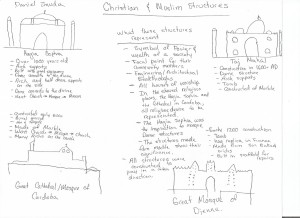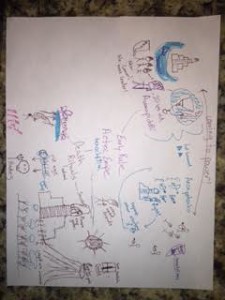I decided to look at the religious structures. More specifically, I just looked at the religious structures mainly from the religions of Christianity and Islam. I analyzed the reading from class, watched the videos on the structures, and did additional research. On my concept map, I have each individual structure; Hagia Sophia, Great Cathedral of Cordoba, Taj Mahal, Great Mosque of Djenne. Under the structures I have some basic facts about them, when they were constructed, what they were made out of, what religion they were apart of, and the structure that they were made from. In the middle of my concept map, I have what these structures represent for their society. For each of the structures I analyzed, they represented and continue to represent wealth and power of their society. Some of these structures have been conquered by opposing religions because of their significance. I learned the Hagia Sophia was an inspiration to the Dome style of mosques, I also learned that the way that the buildings were designed was so that everyone could pray facing the same way. The architecture for the Hagia Sophia was a dome that came down on a square, it was an incredibly difficult structure to engineer. The Taj Mahal was built nearly the same way as the Hagia Sophia was. Many of these structures were built from marble, which signifies how important these structures were to the community.
Concept Map
This Concept Map maybe slightly hard to comprehend due to drawing abilities, but overall this did help me understand the details more greatly by looking at them at a different standpoint. In my concept map I wanted to look more in depth into the early creation of the Aztec Empire. The first true leader of the Aztec empire was actually a new comer to land. The Mexica people were in a time of distress and leaders looked to him. The map showed that during his time. His people fell in the rapid orbit of the different states battling the Azcapotzalco people. The bottom half I wanted to look a little more in depth into their ideas of death. There are three types of deaths that are valued by these people. There was human sacrifice in order to please the gods to keep the sun shining and the rain to prosper the land. The death that was strictly frowned upon was the death of natural cause because it wasn’t viewed as heroic. So bodies would be wrapped and presented to Hades the “dark underworld”. The heroic viewed death was the most praised and the body would be taken to the “ glowing paradise”.
glowing paradise”.
Incas and Aztecs
Group Members: Taylor Archuleta, Lauren Martins, Daniel Zmuda, Jake Hinson
Aztec Empire:
Way way back in the year 1428, there was a group of people called the Aztecs. The Aztecs had formed a three-way alliance with the Tacubans and the Texocans in order to destroy their rival, the Tepanec by conquering the capital, Azacapotzalco. As the three began to conquer more and more they grew even more powerful. By the year of 1440 the alliance had taken over more than 500 small states and approximately 5.5 million people. The empire was ruled by the city of Tenochtitlan which was the strongest military power the alliance had at that time. However, the Aztec emperor didn’t rule each individual state but actually had a local government that enforced law. Just like here in America, we each have a governor and mayors and such but we still obey the law of the federal government. It was the same kind of concept for the Aztec Empire. While the Aztec Empire continued to rise, Hernan Cortes, a Mexican solider under the command of Diego Velasquez. When Velasquez arrived with his men in Tenochtitlan, Cortes went against his commander with an army of gathered men and took over the Aztecs. While the Aztecs were greater in number they were inferior in weapons, which is where the fall of the Aztec Empire took place in 1519.
http://www.history.com/topics/aztecs
Aztec Mythology:
Aztec Architecture:Everything that the Aztecs built was a reflection of their religious, astronomy and cosmology beliefs. Their most dominant, and well known structure is their temples. They built their cities to reflect their religious beliefs, with the City Center in the middle, surrounded initially by Temples, shrines and pyramids. Just beyond the religious structures came the homes and farmland of the Aztec people. The Aztecs used many different symbols on their structures. An Eagle represented the Sun and warriors, Serpents represented water or fire, and the Conch Shell represented fertility. The Aztec’s temples are their most iconic symbols, and were a keystone of their society. They built the structures in order to become closer with their gods. The structures were made with a double staircase, and faced west toward the sun. At the top of the temple it was flat, and used for making sacrifices. Another main structure of the city, was the Emperor’s palace. The palace was huge, it was two stories tall with giant rooms. Only the emperor was allowed to have a two story building.
http://www.legendsandchronicles.com/ancient-civilizations/the-ancient-aztecs/aztec-architecture/
Aztec Engineering:
In the area of the Aztecs there was no iron or bronze being utilized with which to make their tools and weapons. Therefore, they had to create effective tools and weapons without any of these metals. Many Aztec tools were made out of obsidian and chert, very similar to the Native American Indians. Just as the Aztec’s were overcome by the Spaniards, the beginning of copper tool technology had just begun. Aztec tools were so innovative that they even made drills out of reed or bone.
Though the tools were made of stone, obsidian, and chert the Aztecs were able to build amazing structures. They focused on building very strong foundations of their structures, which may be the reason why some of the building are still standing. The reasoning behind these strong foundations was the because of the areas that the buildings were being built. The soil was very soft due to a very warm and damp climate. They also utilized local stones that provided the structures with all the strength they needed as the buildings started going up. Some of these stones included limestone, various rubble, and tezontle (a volcanic stone). Some of these structures are still standing because of the genius engineering of the Aztecs.
http://www.legendsandchronicles.com/ancient-civilizations/the-ancient-aztecs/aztec-architecture/
http://www.aztec-indians.com/aztec-technology.html
Question 1:
The Incas and Aztecs were two incredibly strong empires who have left their mark on the world in many different ways. The Incas and the Aztecs both centered their lives around their religion, astronomy and cosmology. Both empires built temples for their place of worship, and had incredibly extravagant palaces for their emperors. Many structures of both empires have stood the test of time due to the excellent stone work and engineering. Many of the Incas and Aztecs pyramids and temples revolved around the sun, whether it was used to tell the time of year, or for their emperor to sit in. Though they are similar in these ways, they also had many differences.
- « Previous Page
- 1
- …
- 3
- 4
- 5
- 6
- 7
- …
- 12
- Next Page »